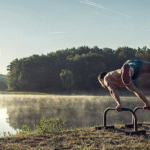How Calisthenics Coaches Track Progress in Private Sessions
- Establishing a Baseline (Initial Assessment)
Before any serious training begins, a private calisthenics coach in Houston will conduct a comprehensive initial assessment. This establishes your starting point across various metrics:
Health and Medical History: To understand any past injuries, current limitations, or conditions.
Body Weight & Composition: Key for calisthenics, as strength-to-weight ratio is paramount. This might involve scale weight, circumference measurements (chest, waist, limbs), and potentially body fat estimations (using calipers or a local DEXA scan in Houston for more accuracy).
Postural & Musculoskeletal Analysis: To identify imbalances, asymmetries, and areas of tightness or weakness that could impact performance or lead to injury.
Fundamental Strength Testing: Assessing max reps (or max hold time) for basic exercises like push-ups, pull-ups (or assisted variations), squats (or pistol squats), dips, and planks.
Range of Motion (ROM) & Mobility Testing: Evaluating flexibility and joint mobility specific to calisthenics movements (e.g., shoulder flexion for handstands, hip mobility for deep squats).
Skill Assessment: For more advanced clients, testing current ability in specific skills like handstand holds (against a wall or free-standing), L-sits, skin the cat, etc.
- Quantitative Performance Metrics (The Numbers)
While calisthenics isn’t always about “heavier weight,” coaches use precise numerical data to track tangible progress:
Reps and Sets (Volume):
Total Volume: Sum of reps performed for a given exercise or movement pattern over a session or week (e.g., total pull-ups completed).
Rep Progression: Gradually increasing the number of repetitions for a given exercise (e.g., from 5 push-ups to 8 push-ups).
Set Progression: Increasing the number of sets while maintaining rep quality (e.g., from 3 sets of 5 to 4 sets of 5).
Time Under Tension (TUT) / Hold Times:
For static holds (e.g., planks, L-sits, handstands, tuck front lever), coaches track how long a client can maintain the position with good form (e.g., holding a plank for 30 seconds, then progressing to 45 seconds).
For dynamic movements, coaches might implement slower tempos (e.g., 3-second eccentric phase for pull-ups) to increase TUT and muscle stimulus.
Progression Level (Exercise Variation): This is unique to calisthenics. Coaches track the progression from easier to harder variations of an exercise.
Examples:
Push-ups: Incline Push-ups → Knee Push-ups → Regular Push-ups → Decline Push-ups → Pseudo Planche Push-ups → Planche Push-ups.
Pull-ups: Band-Assisted Pull-ups → Eccentric Pull-ups → Unassisted Pull-ups → Weighted Pull-ups → Archer Pull-ups → One-Arm Pull-up Negatives.
Squats: Assisted Squats → Bodyweight Squats → Pistol Squat Negatives → Pistol Squats.
Skill Acquisition Milestones: For specific skills, coaches track progress through defined stages:
Handstand: Wall Handstand (various distances from wall) → Freestanding Handstand (for short durations) → Handstand holds for increasing time.
Muscle-Up: False Grip Holds → Transition Practice → Negative Muscle-Ups → Band-Assisted Muscle-Ups → Full Muscle-Ups.
Rest Times: Progress can also be measured by maintaining the same work output with shorter rest periods between sets or exercises in a circuit.
Workout Completion Time: For conditioning-focused calisthenics circuits, tracking the time it takes to complete a set amount of work (or “As Many Rounds As Possible” – AMRAP in a given time).
- Qualitative Observations (The Coach’s Eye)
Beyond numbers, a private calisthenics coach uses their trained eye and expertise to assess progress:
Form and Technique Improvement: This is paramount. The coach observes subtle improvements in body alignment, muscle activation, control, and efficiency of movement. Better form for the same reps is significant progress.
Movement Quality and Fluidity: Are movements smoother? More controlled? Less shaky? This indicates improved neuromuscular control and strength.
Effort and Consistency: The coach assesses the client’s perceived exertion, willingness to push limits, and consistency in applying effort during sessions.
Body Awareness: Has the client developed a better understanding of their own body’s mechanics and how to engage specific muscles?
Posture and Mobility: Observing improvements in resting posture, ease of movement in daily life, and increased range of motion in specific joints.
- Physical Changes (Anthropometric Data)
While aesthetics aren’t always the primary goal of calisthenics, physical changes are often a byproduct of improved strength and body composition:
Body Weight: Monitored consistently (e.g., weekly, at the same time of day).
Body Composition: Regular assessments (e.g., monthly or quarterly) using methods like skinfold calipers, bioelectrical impedance analysis (BIA), or recommending local DEXA scans in Houston for more accurate body fat percentage.
Circumference Measurements: Tracking changes in measurements of arms, chest, waist, hips, and thighs to indicate muscle gain or fat loss.
Progress Photos: Consistent photos (same lighting, angle, clothing, time of day) are excellent visual motivators, allowing clients to see changes they might not notice daily.
- Subjective Feedback (The Client’s Experience)
A good coach values the client’s perspective as much as objective data:
Perceived Exertion (RPE): How hard the client felt the workout was. Consistent RPE for increased work indicates improved fitness.
Energy Levels: Daily energy, during workouts, and recovery.
Sleep Quality: Better sleep often correlates with improved recovery and overall well-being.
Muscle Soreness/Recovery: How quickly the client recovers from sessions and any persistent soreness.
Overall Feeling/Confidence: Has the client’s confidence in their abilities grown? Do they feel stronger, more capable in daily activities in Houston? This qualitative feedback is vital for long-term adherence.
- Tools and Systems Used by Calisthenics Coaches
Digital Training Logs/Apps: Many coaches utilize specialized personal training software (e.g., Trainerize, TrueCoach, Hevy Coach) where they program workouts, and clients log reps, sets, tempo, RPE, and notes. This provides real-time data and visual progress charts.
Video Analysis: Clients often submit videos of their sets for review, or coaches record during sessions. This allows for detailed analysis of form and specific cues.
Physical Journals: Some coaches and clients prefer handwritten logs for simplicity and immediate feedback.
Spreadsheets: Google Sheets or Excel are common for detailed data tracking and charting.
The Role of Progress Tracking in Private Sessions
For a private calisthenics coach in Houston, diligent progress tracking serves multiple crucial purposes:
Motivation & Accountability: Clients stay motivated when they see tangible results and are held accountable for their consistency.
Program Adjustment: Data-driven insights allow the coach to dynamically modify the program, breaking through plateaus, preventing overtraining, and ensuring continuous, safe progression.
Goal Reassessment: As clients hit milestones, tracking allows for collaborative reassessment of goals and setting new, more ambitious ones.
Client Education: Helps clients understand why certain exercises or progressions are chosen and how their body is responding.
Demonstrating Value: Provides clear evidence of the coach’s effectiveness and the client’s investment paying off.
In essence, a private calisthenics coach in Houston employs a multi-faceted approach to tracking progress, combining precise quantitative metrics with expert qualitative observations and valuable client feedback. This holistic strategy ensures that every session is optimized, every progression is safe, and every client is continually moving closer to mastering their bodyweight goals.

How Calisthenics Coaches Track Progress in Private Sessions
Route
Calisthenics Gym Houston Functional Bodyweight Training
Secondary phone: (346) 483-3195
Email: info@calisthenicsclubhouston.com
URL: https://calisthenicsclubhouston.com/
Monday 6:00 AM - 7:00 PM Tuesday 6:00 AM - 7:00 PM Wednesday 6:00 AM - 7:00 PM Thursday 6:00 AM - 7:00 PM Friday 12:00 PM - 6:30 PM Saturday 9:45 AM - 12:00 PM Sunday 3:00 PM - 5:00 PM





